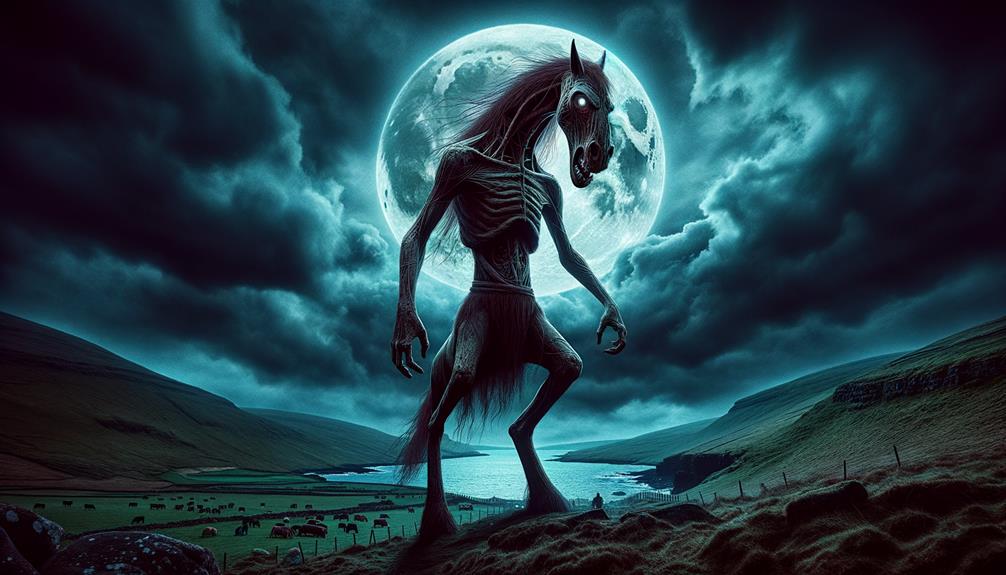Dive into Orkney's Legendary Evil Spirit: The Nuckelavee
The quaint archipelago of Orkney, nestled in the North Sea, holds a chilling secret that 95% of its inhabitants know all too well. This secret is none other than the Nuckelavee, an Orcadian malevolent spirit that has been the subject of my fascination for many years.
Unraveling the Nuckelavee Myth
Described as the epitome of pure evil, the Nuckelavee is a captivating figure in Orcadian folklore. Its grotesque form, a monstrous horse with a rider fused onto its back, a pig-like head, and a blazing red eye, is just the tip of the iceberg. The real horror of this spiteful entity is its alleged powers. It's said to be the source of diseases, epidemics, and even droughts, which speaks volumes about the fear it instills in the residents of Orkney.
Sea-Based Devil: The Orcadian's Nightmare
The Nuckelavee's reputation as a sea-based devil truly highlights its malevolence. Its tale is a fascinating one, wrapped in a blend of fear and respect. The Orcadians' efforts to shield themselves from this terror of the North Sea are particularly intriguing.
So, are you ready to delve deeper into the tales of this North Sea terror?
Understanding the Nuckelavee: A Closer Look
Let's pull back the veil on this mysterious figure and examine the influence it has held over the Orcadian population. The Nuckelavee's story is not just a tale of terror, but also a testament to the power of folklore in shaping communities and their traditions.
Conclusion: The Nuckelavee's Lasting Impact
In conclusion, the Nuckelavee is a powerful symbol of malevolence, deeply rooted in Orcadian folklore. Its terrifying appearance and alleged powers have made it a figure to be respected and feared. This fascinating legend offers a unique glimpse into the rich cultural tapestry of Orkney, a place where ancient traditions and stories continue to thrive.
So, let's continue to explore and appreciate these cultural treasures, shall we? After all, the tales of the past are what shape our present understanding of the world.
The Legend of Nuckelavee

Exploring the Terrifying Maritime Myth of Nuckelavee
Dive deep into the heart of Orcadian and Shetland folklore, and you'll uncover the bone-chilling legend of the Nuckelavee. This malevolent sea spirit embodies the maritime fears and hardships endured by the island dwellers. Imagine a sea demon, restrained by the Mither o the Sea during the balmy summer months, transforming into a dreadful terror when unleashed upon the world. Its grotesque form, as depicted by artist James Torrance, is enough to set your heart racing.
Nuckelavee: The Sea Demon Unveiled
The Nuckelavee, as detailed by folklorist Walter Traill Dennison, is a horrifying hybrid beast, part man and part horse. Forget about your skin-crawling spiders or snakes, this creature is skinless, with pulsating black veins and a single red eye that emits poisonous vapors. It's a terrifying yet fascinating description that mirrors the deep-seated fear of the sea embedded in Orcadian folklore.
An Unseen Threat: The Nuckelavee's Influence
What makes the Nuckelavee even more fearsome is its purported influence that extends beyond water. It isn't just about the terror it inflicts on the sea – the creature is also believed to cause crop failures, livestock sickness, and even epidemics on land. Think of it as a symbol of the constant struggle against the harsh and unpredictable sea, a struggle that has shaped Orkney's rich storytelling tradition.
Escaping the Nuckelavee: Freshwater Crossing
The Achilles' heel of this monster, interestingly, is freshwater. Islanders would often escape the Nuckelavee by crossing streams, a clever real-life example of using nature to combat supernatural threats.
Entwined in the Nuckelavee's legend is a rich tapestry of fear, respect, and survival. It's a tale that resonates with the universal human struggle against nature's unpredictability, a story that continues to shape Orkney's vibrant folklore traditions. This piece of cultural heritage not only engages us with its terrifying imagery but also fascinates us with its symbolism and historical context.
Nuckelavee's Terrifying Appearance
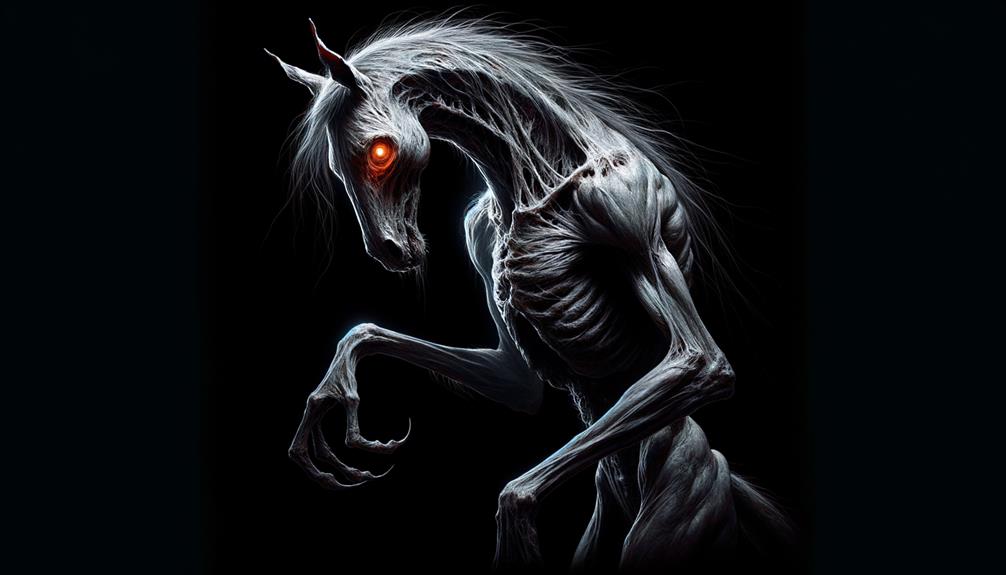
Dive Deep into the Unsettling Appearance of Nuckelavee
The eerie, skinless figure of Nuckelavee, a hybrid of man and horse, is a sight that can make even the bravest of hearts quiver. This intriguing character is an essential part of Orkney Folklore, a testament to the power of storytelling and the creative minds of the islanders. Imagine a creature that combines the most alarming elements of man and beast, causing a ripple of sheer dread.
Nuckelavee: The Orcadian Nightmare
Nuckelavee is a monster of pure malice, often compared to a devil with 58 heads. This description portrays the epitome of raw evil, a figure so grotesque that it's hard to visualize. As a Nuckelavee, the Orcadian malevolent spirit, it's a chilling blend of human and beastly characteristics that makes it the embodiment of primal terror.
A Name Whispered in Fear
The locals were so terrified of this creature that they dared not mention its name without a subsequent prayer, a practice aimed at warding off evil. The sight of its exposed muscles, yellow veins, and a single giant red eye that burns like a raging fire can send shivers down your spine. Add to that a massive mouth that spews a lethal breath, and you have a vision straight out of a nightmare.
A Terrifying Testament to Folklore
This skinless horror, with black blood visibly pulsating throughout its body, is a chilling testament to the power of folklore. The Nuckelavee, an icon of fear and loathing in Orcadian culture, truly stands as a symbol of primal terror. Its presence in the local lore is a testament to the power of imagination and the deep-rooted fear of the unknown.
The Power of Storytelling: Keeping Folklore Alive
The story of Nuckelavee is a perfect example of how folklore keeps our cultural fears and fantasies alive. Stories like these serve as a window into our past, reflecting our collective psyche and shared values. So, next time you hear a tale about a skinless hybrid monster, remember, it's not just a scary story but a part of our rich cultural heritage. Encourage the telling of these stories and keep the tradition alive!
Remember, the story of Nuckelavee is not just a tale of terror, but a testament to the power of folklore and storytelling, an essential part of our cultural heritage. Let's value and preserve this rich tradition, making sure that our shared fears and fantasies continue to find expression in our stories.
Destruction Caused by Nuckelavee
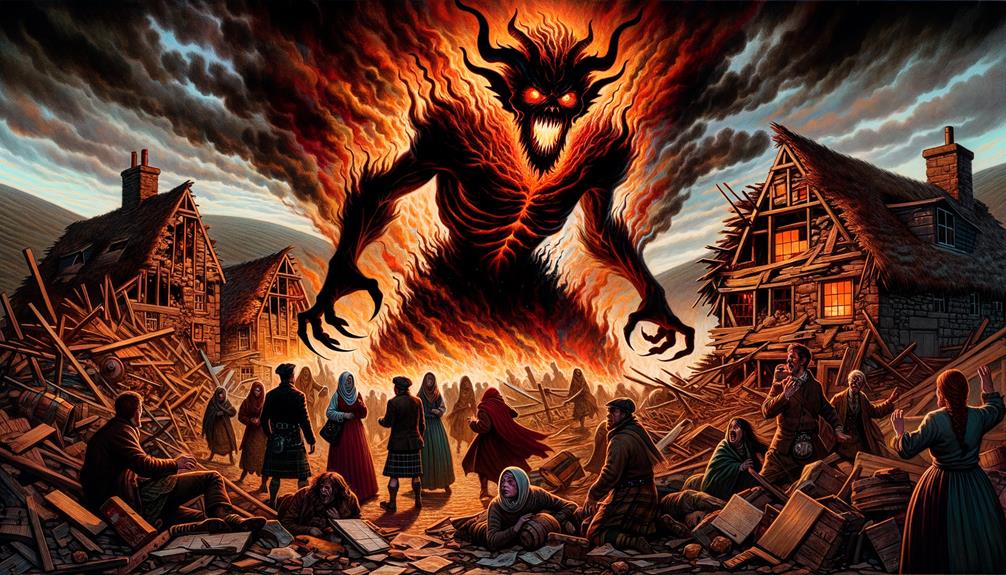
Unveiling the Terror of Nuckelavee: A Dive into Orcadian Folklore
Nuckelavee, engraved in the annals of Orcadian folklore, stands as a symbol of malevolence. It's a creature whose evil deeds have left an indelible mark on the Orkney Islands, changing life for humankind in unforgettable ways.
Nuckelavee's Deadly Wrath
One cannot escape the mention of the 'Mortasheen' when discussing Nuckelavee's destructive influence. This deadly disease, reputedly spread by the spirit, has been at the heart of numerous epidemics, obliterating livestock and causing crops to wither. The creature's putrid stench and lethal breath are not just harbingers of death, but catalysts for widespread devastation.
The Devil of the Sea: A Sight to Behold
Nuckelavee's terrifying appearance further cements its reputation. Imagine a creature with black blood pulsating through its veins, and a single eye ablaze with red fire. This 'Devil of the Sea' is more than just a frightful sight – its very presence is an omen of looming disaster.
Surviving the Nuckelavee in Orkney Islands
The northern regions of Scotland, specifically the Orkney Islands, are no strangers to the fear instilled by Nuckelavee. The inhabitants have found solace in crossing streams, exploiting the creature's known aversion to fresh water. This real-world adaptation to mythical terror showcases the resilience of the human spirit.
The Orcadian Folklore Context
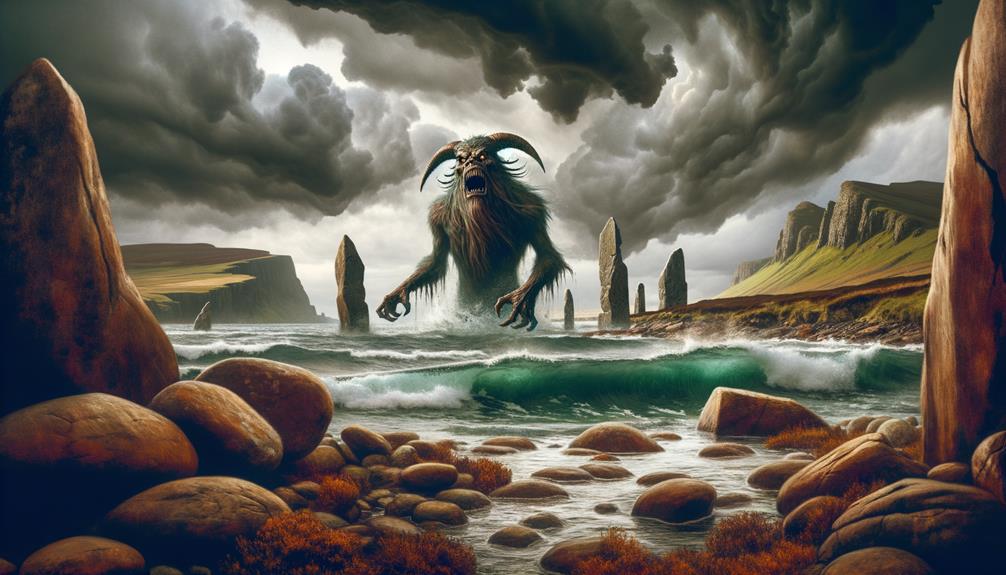
Unraveling the Mysteries of Orcadian Folklore: Decoding the Nuckelavee
Diving into the depths of Orcadian folklore, we uncover a compelling narrative that mirrors the islanders' trials and tribulations with their challenging maritime surroundings. At the heart of this narrative is the term 'nuckelavee', a word that springs from the Orcadian 'knoggelvi', translating to 'Devil of the Sea'. The nuckelavee is a powerful symbol of the islanders' profound fears and struggles, embodying their intense relationship with the sea.
The Nuckelavee: A Symbol of Maritime Struggle
This malevolent spirit of Orcadian folklore, the nuckelavee, seamlessly merges with the Celtic mythology of a water horse. This fusion gives birth to a horrifying hybrid creature – a humanoid torso fused to a demonic, horse-like figure. The nuckelavee's terrifying image stands as a testament to the islanders' unease with their harsh maritime environment.
Decoding the Nuckelavee's Impact on Orcadian Life
The nuckelavee plays a central role in the Orcadian folklore narrative, wielding power and dread. Islanders blamed this entity for a plethora of misfortunes, from crop failures to widespread epidemics. Thus, the nuckelavee has become a symbol of the islanders' maritime struggles, enriching the context of Orcadian folklore.
The Dynamic Interplay of Orcadian Mythology
In an intriguing twist, another key figure in Orcadian folklore, the Mither of the Sea, supposedly restrains the nuckelavee during the summer months. This interplay between different characters adds a unique dynamic to the mythology, illustrating the complexities of Orcadian folklore.
Embracing the Harsh Reality: The Nuckelavee as a Testament
The nuckelavee stands as a stark reminder of Orkney's harsh maritime reality, personifying the islanders' struggles and embedding itself as a crucial thread in the rich tapestry that defines Orcadian folklore.
Interpreting the Nuckelavee Myth
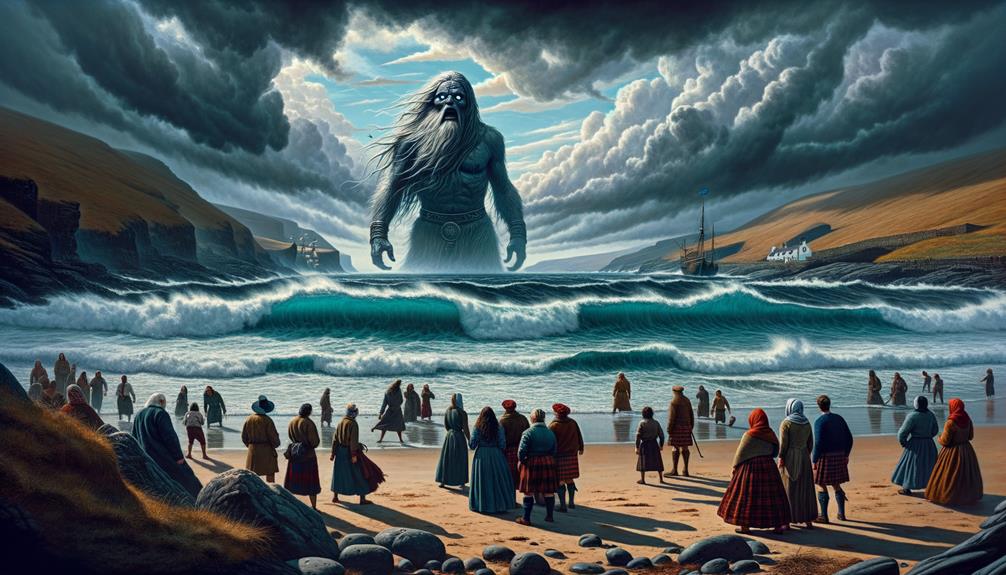
Unveiling the Nuckelavee Myth: Understanding Orcadian Symbolism
To comprehend the enigmatic Nuckelavee myth, one needs to delve into its complex symbolism and the unique cultural context of the Orcadian people. Acknowledge how the creature's chilling characteristics mirror the islanders' inherent fears of their challenging maritime environment. As described in the Scottish Antiquary, the Nuckelavee – a malevolent Orcadian spirit, is portrayed as the most revolting demon, inflicting disease, drought, and the blight of livestock.
1. The Nuckelavee's Frightening Visage
The Nuckelavee is an eerie creature, appearing as a man's torso fused to a horse's back. With no skin to cover its raw flesh, this creature displays a single, glowing red eye that burns like a flame. This grotesque image is a reflection of the Orcadians' primal fears and their struggle with their harsh environment.
2. The Nuckelavee's Destructive Tendencies
Renowned for its summer rampages, the Nuckelavee embodies the islanders' dread of natural disasters and the unpredictable sea. Its destructive habits signify the unpredictable and volatile nature of their maritime environment.
3. The Nuckelavee's Nemesis: The Mither o the Sea
Interestingly, the Mither o the Sea, a powerful entity, can confine this malevolent spirit. This provides a glimmer of hope, symbolizing the desire for protection and control over the whimsical natural forces.
To truly grasp the Nuckelavee myth, we need to understand these symbolic elements, and how they shed light on the Orcadians' interpretation of their environment, their fears, and their hopes. This understanding is not just about tracing their cultural heritage but also about exploring their collective psyche.
*"Unraveling the Nuckelavee myth is a journey into the heart of Orcadian culture, understanding their fears and hopes, their struggles, and their resilience against the challenges of nature."*
Frequently Asked Questions
What Does the Nuckelavee Symbolize?
Decoding the Nuckelavee: Unveiling Its Symbolism
In the realm of symbolism, the Nuckelavee represents something more than just a mythical creature. It mirrors the volatile and unpredictable nature of the sea, chronicling the Orcadian people's deep-rooted fears. This creature is commonly perceived as the harbinger of calamities, underscoring the persistent struggle of mankind against the relentless forces of nature.
The Nuckelavee: A Metaphor for Nature's Fury
We can interpret the Nuckelavee as an embodiment of the sea's perilous character, a metaphor that strikes a chord with the Orcadian people. This creature acts as a powerful reminder of the ongoing human battle against the forces of nature.
The Nuckelavee: A Cautionary Tale
The narrative of the Nuckelavee does more than just frighten—it teaches us about respect for the power and unpredictability of the natural world. Just as the Orcadians lived in fear of this disaster-bringing beast, we're reminded to be cautious and respectful of nature's might.
Unraveling the Symbolism: Real-World Applications
In our day-to-day lives, we can draw parallels between the Nuckelavee's symbolism and our own experiences. For instance, weather phenomena such as hurricanes and tsunamis embody the same unpredictable and destructive forces that the Nuckelavee represents. In this light, we can view the Nuckelavee as a symbol of respect for the power of nature, and a reminder to prepare for and mitigate the effects of natural disasters.
In Conclusion
The Nuckelavee's symbolism resonates with us even today, reminding us of the constant struggle against the forces of nature. By understanding this, we can cultivate a deeper respect for our environment and work towards preserving it. Let's ensure that the tale of the Nuckelavee serves as a guiding light, leading us towards a harmonious co-existence with nature.
What Does Nuckelavee Mean in Scottish?
Understanding the Nuckelavee in Scottish Folklore
In the realm of Scottish storytelling, 'nuckelavee' holds a profound meaning. It's a term signifying the 'Devil of the Sea', a feared entity embodying malevolence. Picture this: a spirit akin to the ocean's version of the boogeyman, submerged in the watery abyss, poised to wreak havoc and devastation.
Diving Deeper: The Sea Devil's Presence in Scottish Mythology
Delving deeper into the Scottish lore, the 'nuckelavee' is not just another creature lurking in the shadows. It's so much more. It's a chilling manifestation of fear, a malevolent force lurking beneath the sea's surface, waiting for the opportune moment to cause chaos. Its mention is enough to send shivers down the spine of the bravest seafarers.
The Nuckelavee: An Agent of Chaos
"Nuckelavee, the *Devil of the Sea*, is more than a mere myth. It's a tangible fear, a cautionary tale whispered among the Scottish seafaring community," as the old tales narrate. The 'nuckelavee' is often depicted as a tormentor, an agent of destruction, always ready to instigate chaos from the ocean's depths.
To truly understand Scottish folklore, one must delve into the tales of the 'nuckelavee.' Its enigmatic presence, imbued with mystery and fear, provides a captivating insight into the cultural narratives woven into Scotland's rich history.
What Is the Evil Horse in Mythology?
Unraveling the Mystery: The Evil Horse Entity in Mythology
An infamous entity in mythology takes the form of an evil horse, often associated with the harsh realities of life. This malevolent figure typically carries with it disease, crop failure, and livestock sickness, symbolizing the human endurance against the often unpredictable, destructive forces of nature.
A Symbol of Struggle: Connecting Human Experiences and Nature's Wrath
This evil horse-like creature stands as an emblem of the constant battles we face against nature's savage forces. Just as we have to combat diseases like the flu or COVID-19, safeguard our crops against pests and droughts, and protect our livestock from illness, this mythological being encapsulates these struggles in a tangible, if terrifying, form.
Harnessing the Power of Mythology: Lessons from the Evil Horse Entity
Drawing from this mythology, we can find lessons applicable to real-world situations. For example, the evil horse's association with crop failure reminds us of the importance of sustainable farming practices. Similarly, its link with livestock sickness highlights the need for proper animal health care products, like vaccinations and antibiotics.
Stand Firm Against the Storm: The Human Endeavor
In the grand scheme of life, the evil horse in mythology symbolizes our ceaseless efforts to keep the natural world's unpredictable and often destructive forces at bay. In a world where climate change and pandemics have become a stark reality, this figure serves as a reminder of the resilience and tenacity inherent in the human spirit.
What Is the Myth of the Kelpies?
Unraveling the Mystical World of Kelpies: A Riveting Scottish Tale
Venture deep into the heart of the Scottish folklore with the chilling legend of the Kelpies. These enchanting water spirits are not as benign as they appear. They cleverly portray themselves as mesmerizing horses to beguile their unsuspecting victims. This narrative underscores the treacherous beauty and inherent dangers lurking within bodies of water.
Kelpies: Bewitching Water Spirits of Deception
The Kelpies' story is a fascinating adventure into a world where enchanting water spirits take on the guise of horses. Their aim? To deceive their unsuspecting victims and lure them into their watery traps. This tale serves as a powerful reminder of the inherent risks associated with bodies of water, woven into a narrative that's as captivating as it is chilling.
A Cautionary Tale from the Depths of Scottish Folklore
In the heart of Scottish folklore resides a tale that has captivated audiences for centuries – the chilling tale of the Kelpies. These bewitching water spirits disguise themselves as graceful horses to beguile their unsuspecting victims. This narrative is a stark reminder of the perilous allure and treachery associated with bodies of water.
The Kelpies: A Masterclass in Deception
"To fall for the Kelpies' charm is to dance with danger." The Kelpies, according to Scottish folklore, are captivating water spirits that shape-shift into horses. Their aim? To trick and devour their unsuspecting victims. This tale underscores the treacherous beauty and inherent risks associated with bodies of water.

